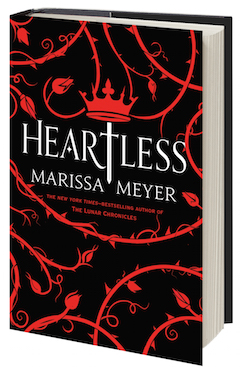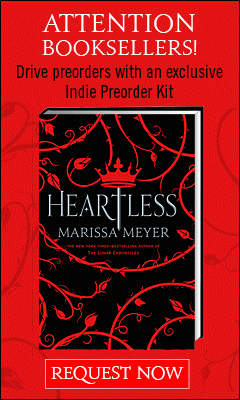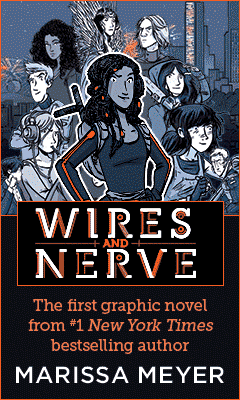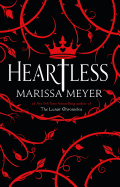Heartless
by Marissa Meyer
The tiny and furious Queen of Hearts who shouts "Off with their heads!" was not always so angry.
In Heartless, an imagined prequel to Lewis Carroll's 150-year-old classic Alice's Adventures in Wonderland, Marissa Meyer (the Lunar Chronicles) introduces the Queen of Hearts as she was at the tender age of 18, when the King of Hearts, a giggling simpleton, is over the moon for her and for the scrumptious pastries she's famous for baking. The young, yet unmarried Queen of Hearts is Lady Catherine Pinkerton of the Kingdom of Hearts, but her friends call her "Cath."
Cath's moody mother, the Marchioness, thinks her daughter is lucky to have caught the eye of the King, but the loathsome match is unthinkable to Cath. Being Queen to that ridiculous royal with his curled mustache and clammy hands would quash any hope she might have of romance, passion, love--and wowing the kingdom with her mouthwatering baked goods; she's been dreaming for years of opening a bakery in town with her brilliant, numbers-minded best friend (and maid) Mary Ann. Cath is well aware of the societal obstacles: "Her mother would never approve of her only daughter, the heir to Rock Turtle Cove, going into the men's world of business, especially with a humble servant like Mary Ann as her partner." She remains undaunted.
But one night Cath's fantasies take another turn. She dreams of a "hazy, beautiful boy" with lemon-yellow eyes, and the next morning, a real-live lemon tree is growing in her bedroom. She harvests a few of the magical lemons to make three perfect tarts for the King's party, obviously not to charm the King but to further her reputation as a baker. (To say Cath is mad about pastry would be an understatement: "The tarts trembled for a moment more before falling still, flawless and gleaming.") That very night at the party, she meets the boy with the lemon-yellow eyes from her dream. He's the King's new court jester, a "Joker" named Jest, and he dazzles her with his wordplay and breathtaking tricks. "Why is a raven like a writing desk?" the handsome acrobatic jester asks the crowd at the King's party, while hanging from a spinning hoop attached to a chandelier. (That particular riddle has many, many answers, doled out throughout.) A shower of confetti, a wink from him, and Cath's new obsession is born. The story of the blossoming, forbidden romance between Cath and Jest is absolutely swoon-worthy, and their witty repartee and obvious chemistry make the suspenseful narrative sizzle. Of course, the relentless courtship of the ardent King, Cath's touch-and-go bakery dream, and the terrifying new threat of the dangerous Jabberwock, "a creature of nightmares and myth," fuel the fire as well.
Those who are well versed in Lewis Carroll's world of Alice will revel in how cleverly, seemingly effortlessly, Meyer works the beloved Wonderland characters into her story; it's always a delight when they pop up unexpectedly. As Meyer says, "All the time while writing this book, I was asking, 'Who is this character when Alice meets them, and how did they become that way?' " In Heartless, for instance, the sassy "half-invisible cat" Cheshire is Cath's friend (who would very much like a tuna tart) and the town cobbler is the hookah-smoking Caterpillar. (" 'Who,' he said lazily, 'are you?' ") Meyer's version of the Hatter's tea party ("not so much a tea party as a circus") is a dramatic, deliciously described tour de force in which Cath wins over an odd, tough crowd of porcupines, bumblebees and boa constrictors with her delectable macarons. Jest tells her, "...you're extra beautiful when you talk about baking. You know you're good at it, and that knowledge lights you up." (This flatters and flusters her, and has her once again cursing her fate as Queen.)
As Carroll does in Alice with the likes of Humpty Dumpty and Tweedledee and Tweedledum, Meyer pulls nursery rhymes into her story. For example, her spin on Peter Peter Pumpkin Eater (who had a wife and couldn't keep her) catapults Heartless into horror, a creepy subplot first only hinted at during the King's party when Peter Peter's pasty-faced, sickly and desperate wife asks Cath for pumpkin pastries with the intensity of a junkie needing a fix. Fans of Edgar Allan Poe's "The Raven" will be pleased to see glimpses of that poem, too, in the Raven's dialogue. It's to Meyer's great credit that the abundant literary allusions never overwhelm, they just liven up the recipe.
What begins as a witty, ingenious and charming romp through the mesmerizing world of Alice darkens and deepens until it grabs its readers by the throat. Will the brave, fierce Cath buckle and marry the King? Will she follow her heart? How many impossible things, as the White Queen says, can be believed before breakfast? Meyer's foray into Wonderland will unhinge hearts and drop jaws as it charms and chills. --Karin Snelson, children's & YA editor, Shelf Awareness








_Julia_Scott_close-up.jpg)